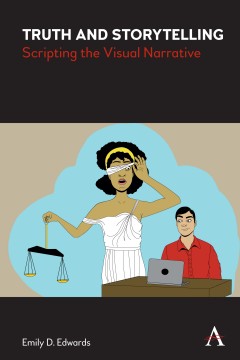Truth and Storytelling
Scripting the Visual Narrative
By Emily Edwards
- About This Book
- Reviews
- Author Information
- Series
- Table of Contents
- Links
- Podcasts
About This Book
There are many books on screenwriting that suggest to writers there are “secrets of Hollywood” and guaranteed formulas for success. The implication is that with the right recipe and a little luck any student can whip out the script that will provide that triumphant red carpet walk toward financial success and global appreciation. It is rare for a book to tell aspiring writers that they may already know the secret of great stories nestled in their own experience: the people they encounter in life, their observations of events, and their personal reactions to them. The intentions of this book is to provide for the creativity writers already have, to help them see the stories waiting to be recognized, recovered, and shaped into the scripts of visual narrative. While the emphasis of this book is on creating scripts intended for production of moving image media, the guide can be adapted to the creativity of various types of storytellers working in a variety of media. One of the needs for art is the mirror, a reflection of human existence and what is glorious, tragic, wonderful, and funny about life. In an age of “post-truth,” where derivative and grotesquely bogus stories are abundant, globally networked, and digitally streamed, this book examines what it means to both artists and audiences when the mirror is consistently distorted, inaccurate, and biased. The book offers a guide for finding authenticity in fictional narrative, regardless of genre or form. The book is intended as a compass for writers to better understand and confront the truths they want to reveal through narrative stories and how to find legitimacy in the fictional characters and situations they create. One element that sets this book apart from others is the use of storyboarding to explain ideas. There are many books that teach fundamentals of writing and producing for the screen, promising the reader great success through formula. This book is a guide for writers in finding their own creative voice.
Reviews
“Emily Edwards offers a fresh approach to ideation and the development of screenplays, laying out existing character types and genres and suggesting ways to mix them up in unique and interesting ways. She also emphasizes the pursuit of truth in fiction that can be more truthful than the recitation of facts.” — Paul Gulino, Professor, Lawrence and Kristina Dodge College of Film and Media Arts, Chapman University, US
“This is a smartly written, comprehensive book that includes many nuances of screenwriting that other guides ignore.” —Evan Smith, Newhouse School at Syracuse University, US
“The overriding thesis of bringing truth to the writing experience, and having that truth reside in someone’s experience, or life, makes this book a valuable contribution to the field.”—Bob Arnett, Old Dominion University, US
Author Information
Emily D. Edwards is the writer/producer/director of many films and has also published books and articles on popular media. She is currently a professor of media studies at the University of North Carolina at Greensboro.
Series
Table of Contents
List of Illustrations; 1. Truth and the Search for Story; 2. Creating Authentic Characters; 3. The Shapes of Visual Narrative; 4. The Structures of Time and Perspective; 5. Outlines and the Spines of Stories; 6. The Truths of Style and Format; 7. Guarded Dialogue and Candid Silence; 8. The Scene and the Story; 9. Honest Revisions; Index.
Links
Stay Updated
Information
Latest Tweets



